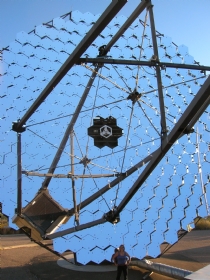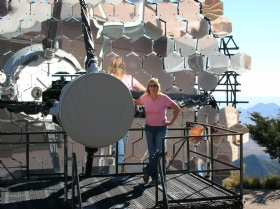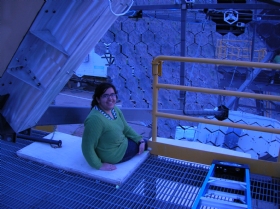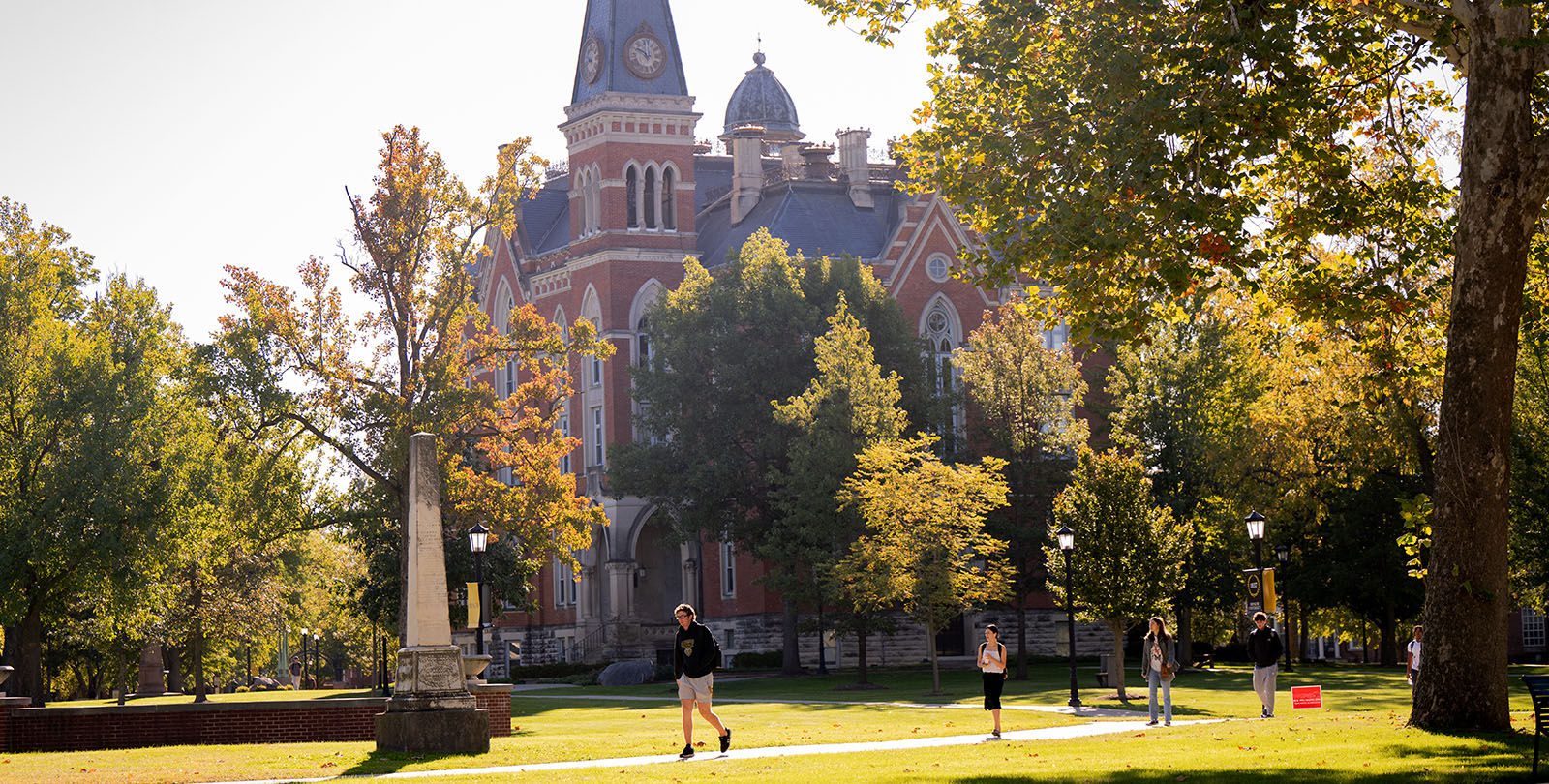News & Media
Professor Mary P. Kertzman
March 18, 2010
Mary P. Kertzman, professor of physics and astronomy, centers her research on four 12m telescopes that are located in southeastern Arizona at the Fred Lawrence Whipple Observatory. The telescopes form an array, referred to as VERITAS, an acronym for Very Energetic Radiation Imaging Telescope Array System.
The telescopes, named T1, T2, T3 and T4, are able to detect astronomical objects that release electromagnetic radiation of highly energetic wavelengths – gamma rays. They are unlike optical telescopes that gather and focus light mainly from the visible part of the electromagnetic spectrum.
Kertzman’s personal favorite is T3 because she helped hang the 345 individual mirrors that make up that telescope.
Kertzman has been involved in VERITAS since its inception. “We started planning for this array more than 15 years ago and came up with the design in 1998. VERITAS is the most sensitive gamma ray telescope in the world,” Kertzman says. “There are only two other systems like it.”
To better understand Kertzman’s research, knowledge of basic physics is essential. “Gamma rays are the highest form of electromagnetic radiation. From lowest energy to highest, there are radio waves, visible light, ultraviolet radiation, X-rays and gamma rays.
“The different regions that we give names to have different wavelengths,” Kertzman says. “Radio waves are very long. Visible light is measured in nanometers. The wavelength of gamma rays is smaller than the nucleus of an atom. So, we don’t talk about wavelengths; we just talk about energy, and it requires different techniques for detecting these things.
“The energy from extraterrestrial gamma rays is converted into particles and antiparticles as the gamma ray passes through our atmosphere. These particles are traveling faster than the speed of light in air. Nothing can go faster than the speed of light in a vacuum, but it’s possible for the particles to go faster than the speed of light in air.
“When something goes faster than the speed of light in air, you get a light flash called Cherenkov radiation. There is a shower or cascade of electrons, positrons and gamma rays coming down through our atmosphere. Since the electrons and positrons are all going faster than the speed of light in air, they are emitting Cherenkov radiation. This radiation is seen as a very brief flash of blue light and can be detected by an array of sensitive light detectors.
“We’re looking for a very fast pulse of light that is seen coincidentally in multiple telescopes. That information allows us to reconstruct this whole trajectory of the cascade, which then allows us to infer what the incoming particles are doing.
“These telescopes can sit out in the open because they’re basically like big light buckets. They have very fast electronics so that they can get an image of this fast burst of light.
“It’s a new field, although scientists have been exploring this technique for a while,” Kertzman says. “The pioneers had a great idea, but it took the development of technology to actually make it work.
“As the field is maturing, there is now a shift from a search and discovery phase to a focus on the astrophysics of the sources. There are more than 100 sources of high-energy gamma rays catalogued. So, now we can actually start looking at the details and focus more on the science of what’s happening in these objects rather on just finding them, which is really exciting.”
The science of what the telescopes have detected has focused on active galactic nucleus (AGN). “They are otherwise normal-looking galaxies that are abnormally bright in the center. It’s a galaxy with an active nucleus.
“We know they are galaxies with super massive black holes – millions to billions of times the mass of the sun at the center. There is material in an accretion disk swirling around the black hole, and somehow the interaction of this accretion disk with the black hole causes energetic jets to be beamed out of the system.
“There is a lot of interest in how this actually happens. When we look at the highest energy emission from these AGN – the gamma rays, as opposed to other wavelengths – we can get a sampling deeper in and closer to where the accretion disk and black hole are interacting.
“It’s exciting that the gamma rays may unravel what’s really happening. A lot of studies now are multi-wave length. So when one of these AGN’s gets active, the gamma ray telescopes look at it, the x-ray telescopes look at it, the optical people and radio people look at it. You can span the whole spectrum during these flares and during the quiescent state and start to unravel what’s really going on.
“From the beginning, I’ve been on the computer modeling side. I started when I was doing my post-doctorate work at Purdue. I worked on simulations of the gamma ray cascade in our atmosphere and on what would be needed to detect this.
“Lately, I’ve focused on the electronics of the telescopes. Every season, we have to tune our computer model of the telescope. Because things change – mirrors become dirty, and the electronics shift with time – we have to constantly recalibrate. Kertzman often takes DePauw student interns with her to Arizona to assist with the research. Last year, Akanksha Chawla ’12 (at left) accompanied her.
Kertzman often takes DePauw student interns with her to Arizona to assist with the research. Last year, Akanksha Chawla ’12 (at left) accompanied her.
“I had the opportunity to observe as we scanned the skies for gamma ray signals, taking in data and laser runs,” Chawla says. “I also learned about the functioning of the array of telescopes and attended a virtual gamma ray school. It gave me a deep insight into the mechanisms underlying VERITAS and all high-energy gamma ray astronomy.
“I was lucky to observe in a time frame that coordinated with scientists from all over the world. I attended dinners and events, and had the opportunity to interact closely with those deeply rooted in the astrophysical domain. Being the youngest – and only undergraduate student there – I felt especially honored that my ideas were respected and my questions answered – as well as my answers, questioned!”
Chawla is a physics and English writing double major and a film studies minor. “After returning to DePauw, I analyzed VERITAS data to compare two contrasting models of data analysis,” Chawla says. “It proved that the one developed by Professor Kertzman was the more efficient of the two – a significant result for us!
“It was a gratifying, rewarding and a once in a lifetime experience,” Chawla says. She will work with Kertzman again this summer to fulfill a Science Research Fellow Program requirement.
In 2009 Kertzman was awarded a three-year Faculty Fellowship to develop a minor in astronomy and one in astrophysics at DePauw. She is also working to develop a course about observational astronomy and a second course on galaxies and high-energy phenomena.
“I hope to structure the astronomy minor so that it is accessible to students who are not physics majors. I think it would be a really nice minor for a liberal arts student.”
Kertzman is one of the founders of Women in Science (WIS) at DePauw. The program was established in 1992 to create a mutually supportive environment in which women science students can achieve their full potential.
Contact Us
Communications & Marketing

Bob Weaver
Senior Director of Communications
- bobweaver@depauw.edu
- (765) 658-4286
-
201 E. Seminary St.
Greencastle, IN 46135